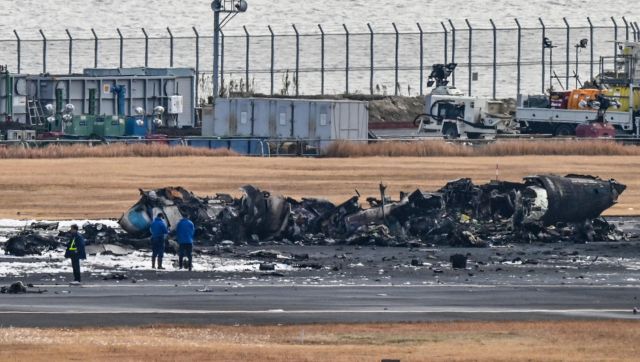Japan, renowned for its resilience in the face of natural disasters, has encountered a turbulent beginning to the new year. The first two days witnessed a series of seismic events, with over 150 earthquakes shaking the nation. Amidst this geological turmoil, tragedy struck as a Japan Airlines passenger plane burst into flames on the second day, adding to the challenges faced by the country.
Plane crash The ill-fated plane carried 379 individuals, comprising 367 passengers and 12 crew members. Remarkably, all occupants escaped unharmed as the aircraft, owned by Japan Airlines, was completely gutted. The incident occurred when the plane collided with a small Coast Guard aircraft engaged in earthquake relief operations. Unfortunately, five crew members lost their lives, while the surviving member was the captain. Earthquake toll Japan’s seismic woes began on day one of the new year, as the nation experienced more than 150 earthquakes, measuring 7.6 on the Richter scale. Homes crumbled, roads caved and even cars on the streets trembled, creating a scene of widespread destruction. Despite the intensity of the earthquakes, Japan managed to minimise the damage with the death toll standing at 48 until yesterday. Rescue operations face significant challenges, particularly in the Ishikawa Prefecture, one of the worst-affected regions in North Japan. Damaged roads, blocked pathways, landslides and reports of fires have hindered the swift execution of rescue efforts. “We have been making all efforts to gather information since yesterday evening, but the blockage of roads means it is extremely difficult to access the northern part of the Noto peninsula,” said Prime Minister Fumio Kishida. National response Japan has mobilised extensive resources, deploying thousands of army personnel, firefighters and police officers to the affected areas. As of the latest reports, 120 individuals still await rescue, emphasizing the ongoing urgency of the situation. Japan’s preparedness for natural disasters stems from a multi-faceted approach. The nation, sitting on seismic fault lines, has implemented strict building codes, holding architects accountable for up to 10 years in case of building defects. Regular drills, including a crisis simulation on Disaster Preparedness Day, observed annually on 1 September, involve the participation of the prime minister and ministers. Japan’s proactive measures in crisis management serve as a model for the world, especially considering the country’s vulnerability to earthquakes. As Japan battles the aftermath of earthquakes and a plane crash, it stands as a testament to the nation’s preparedness and resilience. The juxtaposition of the recent crises against historical tragedies, such as the Great Kanto Earthquake of 1923, emphasizes the importance of disaster management. The lessons from Japan’s commitment to readiness serve as a global reminder that proactive measures can mitigate the impact of natural disasters and save lives. Views expressed in the above piece are personal and solely that of the author. They do not necessarily reflect Firstpost’s views. Read all the Latest News , Trending News , Cricket News , Bollywood News , India News and Entertainment News here. Follow us on Facebook, Twitter and Instagram.


)

)
)
)
)
)
)
)
)



